Amla Benefits, Dose, How To Use, Side Effects, Home Remedies
Amla or Amalaki can be said to be the most used Ayurvedic ingredient. It is both a food and medicine. This small fruit is stuffed with innumerable health benefits that can ever be imagined. The word Amla refers to sour, which is its predominant taste. Its botanical name is Emblica officinalis or Phyllanthus emblica belongs to Euphorbeaceae family (Eranda kula)
Table of Contents
How to consume amla powder, fruit and murabba?
If fresh Amla fruit is available, then you can eat it as such, or make salads, chutney, pickle with it and enjoy the fresh Amla fruit in different ways. If fresh Amla is not available, then Amla powder can be consumed.
How To Consume Amla Powder?
If you wish to take Amla, then consuming chyawnaprash is a good way. But for some reason, if you do not like chyawanprash, you can make Amla recipes along with different liquids, based on your body type, body needs, disease conditions and Dosha imbalance.
Before food or after food?
Amla is well tolerated both ways. If the digestion strength is very good, then it can be taken before food.
Amla for Vata balance
If you have Vata imbalance, like joint diseases, gas trouble, then Amla can be taken along with Sesame oil (gingelly oil). The quantity can be – one teaspoon of amla with two teaspoons of sesame oil. If you do not like the taste of sesame oil, you can make a paste of amla powder and sesame oil and swallow it with hot water.
1 teaspoon of dried gooseberry powder is mixed with a teaspoon of sesame oil and consumed with lukewarm water. This is because, usually after consuming sesame oil, lukewarm water is advised for better digestion.
Evening is the time when Vata is more dominant. So, to balance Vata Dosha, this remedy can be taken in the evening.
If needed, 100 grams of dry Amla powder can be made into a combination with 100 ml of sesame oil. Mix thoroughly and store it in a glass jar. Whenever required, 1 – 2 teaspoons can be consumed.
Amla for Pitta balance
If you want to achieve Pitta balance, if you have digestion problems, or some skin related issues like acne, you can have Amla along with ghee (clarified butter). The dose can be – one teaspoon of Amla churna with one teaspoon of clarified butter. Follow it up with a glass of hot water.
1 teaspoon of dried gooseberry powder is mixed with a teaspoon of ghee and consumed with lukewarm water. This is because, usually after consuming ghee, lukewarm water is advised for better digestion.
Because ghee and Amla both are Pitta balancing, afternoon is the best time to administer this remedy. Afternoon is the time of Pitta dominance.
If needed, 100 grams of dry Amla powder can be made into a combination with 100 grams of ghee. Mixed thoroughly and stored in a glass jar. Whenever required, this – in 1 – 2 teaspoons dose can be consumed.
Keep in mind that if taken in excess, Amla with ghee can cause slight weight gain.
Another way to take Amla powder for Pitta is to take it along with jaggery. Learn how to do it – Amla Home remedy for Pitta
Some people boil its powder with jaggery and consume. This is also a very valid method of intake.
Amla for Kapha balance
For Kapha balance, for diseases like obesity, respiratory diseases etc, you may have Amla churna along with honey.
If none of these are available, you can simply add amla powder into water and drink it as such.
So in one way or the other, make sure to include some Amla in your diet.
Amalaki with honey causes weight loss. This remedy is good for obese persons.
Morning is the time when Kapha is most dominant. If one has high Kapha and desires to take Amlaki, then morning is the best time to take it along with honey.
If needed, 100 grams of dry Amla powder can be made into a combination with 100 grams of honey. Mix thoroughly and store in a glass jar. Whenever required, this – in 1 – 2 teaspoons per day dose can be consumed.
Amla for Pitta and Kapha Dosha –
Amla is made into a combination with other two herbs – Haritaki and Vibhitaki – this combination is called Triphala. Triphala balances Pitta and Kapha Dosha.
Amla for skin and eye health
Amla for improving skin qualities and complexion –
A teaspoon of Amla is mixed with half a strand of saffron and consumed with water.
A teaspoon of Amla is mixed with a quarter teaspoon of turmeric and consumed with water.
Amla for eye improvement –
Compared to Dhatri, Triphala is more effective in improving eyesight. Hence, it makes more sense to administer Triphala than Amalaki for good eyesight.
Amla powder for gray hairs, respiratory health
Amla powder for gray hairs –
Equal parts of Gooseberry powder and Bhringaraj powder are mixed. This is administered in a dose of half a teaspoon 2 times a day after food with water for a month’s time.
Amla powder for respiratory health –
Amla powder with cinnamon and turmeric is good for respiratory health.
Amla with ghee and turmeric is good for allergic rhinitis and hives
Amla chatpata is another combination made out of Amla with spices like cinnamon, ginger and jaggery.
Consuming Amla during winter –
Because it is a natural coolant, it can cause increased dryness of skin and hair. To counter this effect, it is consumed along with sesame oil.
Amla pickle
Pickle made with a few fruits of Amla pulp slices mixed with 1 tablespoon of mustard oil with a little salt, curry leaves, green chilli (optional) and cumin seeds is useful to improve digestion strength.
Medicinal qualities
Guna (qualities) – Guru – heaviness, Sheeta – coolant
Rasa (taste) – Has five tastes. – sour, sweet, bitter, astringent and pungent (all the five tastes, excluding salt). Sour is the dominant taste.
Vipaka (taste conversion after digestion): Madhura (sweet)
Veerya (potency): Sheeta (cold)
Effect on Tridosha: Tridoshahara – It balances all the three Doshas.
The fruits of gooseberry / Emblica officinalis have sweetness as its primary taste and sourness and astringent as secondary tastes.
Also known as dhAtriphala, the gooseberry fruit is tridoSha pacifying. By the virtue of its sourness, it addresses the increased vAta and by the virtue of its cold potency and sweetish taste it appeases the aggravated pitta. The aggravated kapha gets addressed by the qualities of dryness and astringent taste of the Embilica officinalis fruits.
Gooseberry fruits are beneficial in patients with urinary ailments like dysuria and are also wholesome to be consumed as such in patients of prameha.
It relieves constipated bowels when taken regularly. Gooseberries act as a tonic in maintaining the vision, physical strength, complexion of skin, and eroticism.
It is one of the intelligence promoters widely used in the form of rasayana chikitsa.
AmalakI is beneficial to patients with itching sensation, skin diseases, fever, uncontrolled thirst, burning sensation within the channels of the body, anorexia etc.
The fresh juice and raw fruits of AmalakI is cold in potency, tastier to drink, sweetish in taste, alleviates kapha doSha, reduces fever and burning sensation. It promotes virility and increases the lifespan of the individual when taken in the prescribed format of dosages and rasayana therapy modality.
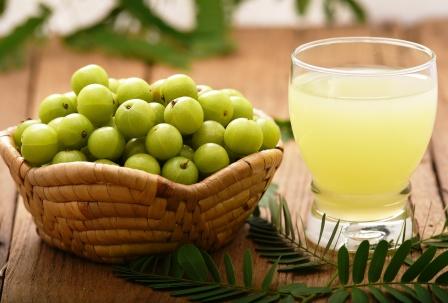
For weight loss, weight gain
Amla being rich in nutrients and antioxidants is useful in weight loss. For this purpose, its powder – half a teaspoon 2 times a day before food is advised along with a teaspoon of honey. Honey being anti kapha, is useful in weight loss and also it potentiates the effect of amla.
How To use Amla For Weight Loss?
For weight gain –
If amla powder is to be consumed, a teaspoon of it is mixed with a teaspoon of ghee and gulped with a cup of lukewarm water. If amla fruit is consumed for weight gain, then a teaspoon of ghee is consumed after eating amla, then a cup of hot water is drunk. If it is taken along with honey, then it does not cause weight gain.
Amla combinations
Amalki with Aloe vera juice – for liver health, radiant skin and long hair.
Gooseberry, mint leaves and jaggery in hot water – useful to have a calm stomach, useful in acid peptic disorders.
Amla candy – usually made with sugar or jaggery. It is good for gastritis, to gain weight and to cool down the body during summer.
Amla is mixed with flours of black gram, green gram etc to prepare several Indian dishes such as Vada. (read how to prepare Amalaki Vada)
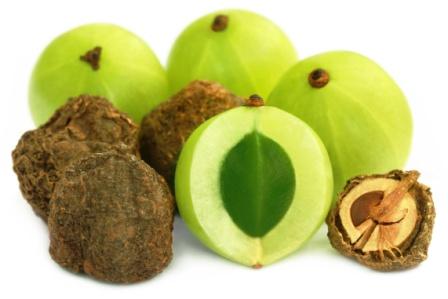
Charaka Sutrasthana 27
Amla (Emblica officinalis Gaertn.) contains all tastes except salt
Rooksha – dry
Swadu – sweet
Kashaya – astringent
Balances Kapha and Pitta.
Sushruta Samhita: Amalakyadi, Parushakadi and Triphala group of herbs.
Vagbhata: Parushakadi group of herbs.
Traditional benefits
Vayasthapana – Of all the anti-aging herbs – Amla is the best.
Chakshushya – good for eyes, improves vision
Sarvadoshaghna – Balances Vata, Pitta and kapha
It balances Vata due to its sour taste
It balances Pitta dosha due to its sweetness and coldness
It balances Kapha dosha due to dryness and astringent properties.
It is quite similar to Haritaki in quality.
Raktapittaghna – useful in bleeding disorders.
Pramehaghna – Useful in diabetes and urinary tract disorders.
Vrushya – aphrodisiac
Rasayana – anti aging, rejuvenative
Kanthya – useful in throat diseases, improves voice, good for the throat.
Hrudya – good for heart
Daahahara – relieves burning sensation
Jvarahara – useful in fever
Rasayana – anti aging, rejuvenative
Amalaki churna is used in preparing a type of salt called Vida Lavana
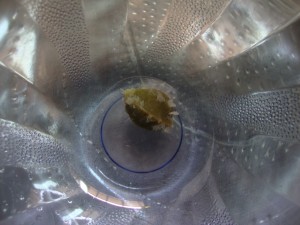
For Power, Vigor
The reference for this Amla remedy is taken from a traditional text book for Ayurveda Practice, called Chakradatta.
Watch the video of this remedy here
एवमामलकं चूर्णं स्वरसेनैव भावितम् ।शर्करामधुसर्पिर्भिर्युक्तं लीढ्वा पय: पिबेत् ॥
एतेनाशीतिवर्षोऽपि युवेव परिहृष्यते ॥ ४ ॥ चक्रदत्त वृष्याधिकार
evamāmalakaṃ cūrṇaṃ svarasenaiva bhāvitam |
śarkarāmadhusarpirbhiryuktaṃ līḍhvā paya: pibet ||
etenāśītivarṣo’pi yuveva parihṛṣyate || 4 || cakradatta vṛṣyādhikāra
एवमामलकं चूर्णं – evamāmalakaṃ cūrṇaṃ – Amla powder
स्वरसेनैव – svarasenaiva – is mixed with amla juice
भावितम् – bhāvitam – ground together till the juice evaporates. Thus amla powder is fortified with amla juice.
शर्करामधुसर्पिर्भिर्युक्तं – śarkarāmadhusarpirbhiryuktaṃ – mixed with equal quantity of sugar, honey and ghee. But honey and ghee should not be taken in equal proportions.
लीढ्वा – līḍhvā – this semi solid paste is mixed well.
पय: पिबेत् – paya: pibet – After consuming this, milk is consumed.
एतेनाशीतिवर्षोऽपि – etenāśītivarṣo’pi – by doing so, even an 80 year old person
युवेव परिहृष्यते – yuveva parihṛṣyate – can gain power and vigor of a young man!
Amla Aphrodisiac Remedy In Herbal Jam Form
Let’s learn in detail, how to make it –
First we take Amla fruits, cut them into pieces, Crush it in a mortar and pestle or in a blender. Squeeze and extract juice.
Take amla powder equal to the quantity of amla powder. Mix it and grind it with the juice.
Add equal quantity of candy sugar, honey and a little less quantity of ghee to it. Mix well.
This is consumed in a dose of 10-20 grams at night, by adults.
After taking this, a cup of milk can be consumed.
This is the aphrodisiac remedy.
Though advised for adults, this can be an immunity boosting remedy for people of all age.
If used in children, then dose can be 3 – 5 grams, once a day.
This is preferably consumed 30 minutes before food, but it can be taken after food as well.
Seek your doctor’s advice before giving it to children and pregnant mothers or if the person is taking any other medicines already and wishes to take this remedy.
People with diabetes should avoid it, as it contains sugar.
However, it is considered as safe for people with high blood pressure.
There are no known side effects with this remedy. After preparation, it can be stored for a period of 1 – 2 weeks.
Amla side effects
Being a natural coolant, amla, in some people can increase urine frequency. For them, it is best to take amla with a pinch of sandalwood powder. This should resolve the problem.
It is safe in children, during pregnancy and lactation.
But because it is a natural coolant, some people with colds or coughs may observe that the symptoms are worsening, if they are eating Amla fruit or taking Amla powder alone.
Consuming excess of Amla fruits – More than 4 per day can cause skin dryness in some people. Some people also feel dryness of hair due to this. Dryness is associated with coldness. Hence, taking excess of amla can cause dryness. For such people, it is best to take it along with a little ghee or oil.
Read related: How to eat Amalaki based on your body type
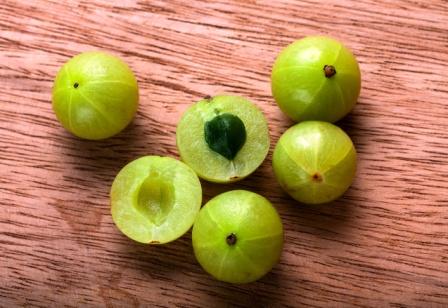
Amla leaves
Amla leaves – taken orally, or applied as a paste on hair, is to good to improve hair qualities.
Interaction with medicines, supplements
Can this be used while taking Homeopathic medicine?
Yes. This product does not react with homeopathic medicine.
Can this medicine be continued while taking supplements like multivitamin tablets, Omega 3 fatty acids etc?
Yes. Generally, this product goes well with most dietary supplements. However, if you are taking more than one product per day, please consult your doctor for an opinion.
With western
medicines
Seek your
doctor’s advice if you are taking this product along with other western
(allopathic / modern) medicines. Some Ayurvedic herbs can interact with modern
medicine.
If both Ayurvedic and allopathic medicines are advised together, then it is
best to take Allopathic medicine first, wait for 30 minutes and then take the
Ayurvedic medicine.
FAQs
Is frozen amla as good as fresh amla?
Any fruit, which is fresh is always better. However, due to seasonality of the Amla fruit, it is not available throughout the year. Hence, for the sake of convenience, it can be frozen and used as and when required. I would say, it is not as good as fresh amla, but still good enough to use.
Read related: Amla remedy for excess body heat
Amla with milk
Is Amla incompatible with milk?
Yes, all sour foods and herbs, including amalaki, are incompatible with milk, because Amla curdles it.
Solution? You need to give a gap of at least 30 minutes between intake of Amla and milk. For example, if you are prescribed Amla capsule, along with Turmeric capsule with milk, then take Amla capsule before food, have food, and then take turmeric capsule with milk. This will ensure that the milk and amla are separated.
Read related – How to make Amla hair oil
Dr Hebbar –
I request you to mix amla powder or paste with milk and see for yourself.
Questioner – I know you are talking about milk getting sour but that does not mean how it will metabolism in our body that is an entirely different process.
Is milk to be avoided with Amla? In Astanga Hridaya, in the vajikarana chapter, Vagbhata prescribes amla powder with milk.
In Ashtanga Hrudaya, Uttaratantra, Vajikarana Chapter (40th chapter) – 27th verse, there is a reference of usage of long pepper, amla, processed with amla juice, sugar candy and honey. – Here, milk is not used in processing the product, but is only used as Anupana. Moreover, by processing it with honey and sugar candy, the product would be sweeter than sour. Hence, milk after drinking can be substantiated.
Is amla hepato-toxic? I read in Wikipedia that hidrolizable tannins can be hepatotoxic.
Tannins only in a very high dose, amounting to 20-30 amla fruits per day would be toxic. But no one takes that amount of amla in a single dose.
Are amla capsules and tablets as effective as powder?
Amalaki powder gets absorbed and shows effect more quickly than tablets and capsules. More often capsules contain only selected extracts of the fruit rather than the whole herb.
Ayurveda recommends whole herbs rather than extracts.
Can Amla be taken throughout the year?
Yes. But it is always best to give a break once in a while, when using any Ayurvedic herb. If one is taking this fruit throughout the year, because it is a coolant, consider stopping it during winter.
Does amla cause any type of bleeding?
No. Usually coolant herbs are styptic in nature. Amla is a coolant fruit. This is why, it is used in bleeding disorders such as nasal bleeding, menorrhagia. In children with repeated nasal bleeding, amla hair oil is advised for the same reason.
Q: Do Amla candy and Amla ka murabba have the same benefits as Amla powder? Can I take them on an empty stomach in the morning with lukewarm honey-lemon water? Or what is the best time to take it?
A: I assume that Amla candy is Amla + sugar. Murabba is also made with amla fruits dipped in sugar syrup. So, I think they both should be similar. Morning or afternoon, one hour before food is the best time to take it. You can take it with honey-lemon water.
Q: Is Amla chutney recipe a great way to consume Amla?
A: Yes it is. You can make Chutney with Amla pulp paste by adding a few spices and reap its benefits.
Q: What are the health benefits of amla juice?
A: Amla juice is made with fresh fruits with sweetening agents. It helps to balance Pitta and is useful to relieve burning sensation. Other than this, it contains all the inherent benefits of Amalaki.
Q: Is eating Amla during pregnancy good?
A: As per Ayurveda, Amla can be consumed during pregnancy. But make sure that the powder or fruit that you collect from the market is of very good quality.
Can Amla murabba be eaten on an empty stomach?
Usually those substances that cause stomach irritation are advised to be taken after food. But in the case of Murabba, Amla, though having a sour taste, is soothing to the stomach, so is the sugar syrup used in Murabba. Hence, it can be taken on an empty stomach / before food.
Does drinking Amla juice create weakness and impotence?
No. In fact, Amla juice is indicated to improve strength and sexual power.
Does boiling of Amla or gooseberry cause loss of its phytonutrients?
Vernacular names
Hindi name: Amla, Awla, Anwala, ambala, amlika, anwala.
English name: Indian Gooseberry
Telugu name: Usiri Kaya, Usheeri Kayi, amalakamu, nelli, peddausiri, putlayusirika, usiri,usirikayi.
Tamil name: Nellikkai, perunelli, nellikai.
Malayalam name: Nelli
Kannada name – Nelli, nellikay
Bengali name – Aamla, Aamro, Amla, Aamalaki
Punjabi name – Aamlaa, Ambul, Ambalo
Gujarati name – Aavla, Aamlam, Aamli
Farsi name: Amlaj
Kannada name – Nelli, Nelli Kayi, Bettada Nelli Kayi
Malayalam name – Nelli, nellikai
Konkani name – Avalo
Urdu name – Aamla, amal khushk.
Arabic name – Amlakhushk
Pali name – Amalak
Marathi – Aouli, avalkati, avil, avla
Manipuri name – Heikru
Assamese name – Amlaki, Amla, Amlokhi, Amlok
Use of Amla in Rasayana
Amla is extensively used in many Ayurvedic anti aging medicines such as Brahma Rasayana, Chyawanprash etc. Amla fruit alone is also an excellent anti ageing recipe.
Charaka explains usage of amla fruit in the following manner for rejuvenation benefits:
Source: Charaka Chikitsa Sthana, 1.3/9-14
- A person among the cows, living on cow milk for one year, mentally reciting Savitri Mantra with Celibacy (Brahmacharya) and controlled senses should at the end of the year,
- On a suitable day of the white fortnight (15 days, leading to full moon day) of Pushya (January- February), Magha (February- March) or Phalguna (March-April), observe fast for 3 days and
- Enter into a garden of Amalaki – Indian gooseberry fruit – Emblica officinalis.
- He should then climb upon an Amalaki tree laden with big fruits.
- Holding one such fruit in hand, he should stay there reciting Brahma Mantra (Omkara chanting) till the fruit gets impregnated with Amruta (Ambrosia).
- Ambrosia will come to that fruit for a moment due to the Sacred effect of Mantra, these fruits become sweet like sugar and honey in taste, unctuous and soft.
Benefits:
- Long life with youthfulness regained, depending on the number of Amla fruits he takes in this process.
- He becomes brilliant, like the Gods. He will be blessed with Shree (auspiciousness), the Vedas (knowledge) and Vak (Divine oration power) .
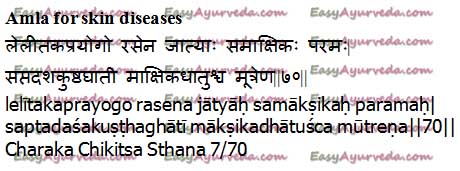
Amla for skin diseases
Charaka Chikitsa Sthana 7/70
Administration of Lelitaka (purified Sulphur) along with the juice of Amla together with honey is the remedy par excellence for the cure of 18 types of Kustha (skin diseases
Amla in Takradhara
Use of Amla in Takradhara procedure:
Takradhara is a traditional Ayurvedic procedure used for the treatment of psoriasis, hypertension etc. Here, medicated buttermilk is poured over a particular body part for a specified period of time.
To prepare the medicated buttermilk (Takra), amla is used, as below.
- The powder of Amalaki and water are taken in the mentioned proportions
- They are heated on moderate fire on the stove until 1/6th of water remains (i.e. until 38 tola – 456 grams)
- The contents are filtered
- To this equal quantity of sour buttermilk – 38 tola (456 grams) is added
- The medicine for Takra Dhara is ready for use
- Read more about methodology and benefits of Takradhara treatment
Amla for dysuria
Tree turmeric (Daruharidra) with the juice of Amalaki – Phyllanthus emblica mixed with honey is useful in curing Paittika type of Dysuria. – Charaka Chikitsa Sthana 26/53
Amla during periods
During periods, Vata and Pitta Dosha can go up. Amla balances both these two Doshas, hence very useful during periods. But if the bleeding is less or periods are occurring late (once in more than six weeks), then it is best to avoid Amla.
Amla remedies for gray hair
(consult your doctor for the right advice)
- Amla with Coconut Oil: 1 cup coconut oil + 2 tbsp amla powder.
Boil coconut oil in a pan and add this powder to it. Heat it till this mixture turns dark brown. Store this oil in a bottle and use regularly. - Amla With Almond Oil: heat almond oil and add this powder to it. Allow it to boil until it becomes dark in color. Let this oil cool and then pour it into a bottle.
- Amla With Lemon Juice: Mix gooseberry powder with a few drops of lemon juice and 1 tbsp of curd to make a smooth paste. Apply this paste on the scalp and leave for 45 minutes. Wash it off with warm water. Repeat this remedy every alternate day until you see positive results
Can I leave amla powder on hair overnight?
It may cause dryness of hair.
If you wish to leave amla powder on your hair, better to make a paste with sesame oil or coconut oil. Apply it on your hair. Next day, in the morning, wash the hair. This way, there will not be dryness of hair and you will benefit due to the good effects of Amla.
The same thing can be done with other herbs that benefit hair – such as hibiscus flower powder or Bhringaraja or wild indigo.
Seed kernel qualities
Amla seed kernel is sweet and astringent. It is
Vrushya – natural aphrodisiac
Pradara – uterine bleeding disorders such as menorrhagia, metrorrhagia etc
Chardi – vomiting
Balances Vata and Pitta
Kasahara – relieves cold and cough
But seed kernels should be avoided during excessive diarrhea, abdominal colic, puerperal disorders and in pure Vata conditions.
Laghu – light to digest
Kashaya – astringent
Balances Kapha and Vata Dosha
Madakrut – can cause intoxication on excess use.
useful in –
Trut – excess thirst
Chardi – vomiting
Ancient interesting facts about Amla
In Vedic period, it was added to bathing water. Charaka has mentioned Amalaki as the best among anti-aging herbs.
Amalaki has sourness as its main taste. Usually sour taste increases Pitta but Amla balances Pitta.
Though amla has a slight sweet taste, it is used as an ingredient in many Ayurvedic medicines like Mehari Choorna, Nishamalaki Choorna etc.
Amla is the main ingredient of Chyawanprash.
Amalaki contains five tastes excluding salt taste.
Amla Rings – Water Purification

Picture courtesy – Ashwin Sampathkumar Twitter @Ashwinsampathk
In ancient times, Amla wood was used to prepare rings which were put in the well. It was so immersed that 2 – 4 such bing rings are immersed, deep in the well. It was done so, to purify water. The amla wood can absorb and cleanse dirt and microbes from the water. So, the well water was rendered potable due to such Amla rings in the wells!
Mr Hariharan Iyer – Not just Amla Rings alone. People used to put an Amla Wood Flooring at the Bottom of the well, There is a proverb in Malayalam “Kshamayute Nellippalaka” etc. which means the Amla Floor of Patience meaning that you have reached the bottom!
Sanskrit Synonyms
Amalki,
Amalaki – having sour taste
Dhatri – takes care of the patient like a mother
Tishyaphala – Fruiting season in Pushya masa ( Nov – Dec)or the fruit are Auspicious,
Divya – fruit is auspicious
Amrutaphala – As good as nectar
Vayastha, Vayasya – anti aging
Tishyaphala,
Sheetaphala – has coolant property
Jatiphalarasa – The juice of fruit is medicinally very useful
Seedurasa,
Seeduphala,
Vrishyaphala – Improve Sukra dhatu
Shivam – Always beneficial
Shanta
Varshaphala
Korangaka – Commonly cultivated in Tamil Nadu and Andhra Pradesh
Vrutta phala – Fruit is globose
Kolam – Fruit is 6 gm
Amala – Purifies the body
Classical categorization
Charaka Samhita
Jvaraghna – Group of herbs that are useful in fever
Kasaghna – Group of herbs that are useful in cough, cold
Virechanopaga – Group of herbs that are useful to induce purgation.
Kushtaghna – Group of herbs that are useful in skin diseases
Vayasthapana – Anti aging group of herbs
As per Charaka, it is one of those ingredients that can be taken on a daily basis. (Pathya). (Reference: Charaka Samhita Sutrasthana 5/12)
Bhavaprakasha Nighantu – Haritakyaadi varga
Kaiyadeva Nighantu – Aushadi varga
Dhanvantari Nighantu – Guduchyaadi varga
Raja Nighantu – Aamradi varga
Shodala Nighantu – Guduchyaadi varga
Morphology, Distribution
Morphology
Emblica officinalis is a medium sized tree growing up to 8 – 18 meter in height. Leaves are simple, subsessile, light green, resembling pinnate leaves. Flowers are small, greenish-yellow in color. Fruit is nearly spherical, light greenish-yellow, smooth, shining with 6 vertical stripes. Seeds are trigonous.(b)
Distribution
Emblica officinalis is available naturally or cultivated throughout Tropical parts of India. It is found in Nepal, India and Sri Lanka, throughout South-East Asia to southern China.(a)
Chemical Constituents
Fruit juice of amla contains phenolic constituents like gallic acid, L-malic acid 2-o-gallate, Mucic acid 2-o-gallate, Corilagin Chebulagic acid, putrajivain A, elacocarpusin, mucic acid, 1-o-galloyl-β-D-glucose, Mucic acid 6-methyl ester 2-o-gallate, Mucic acid 1,4- lactone 2-o-gallate, Mucic acid 1-methyl ester 2-o-gallate, Mucic acid 2-o-gallate, Mucic acid 1, 4-lactone 6-methyl ester 2-o-gallate, mucic acid 1, 4-lactone 3-o-gallate, mucic acid 1,4-lactone 3,5-di-o-gallate (d)
Nutritional Values
100 gm of Amla contains: Calories: 96(energy), Carbohydrate: 6.9 grams, Iron: 1.2 grams, Protein: 0.9 grams, Fat: 0.1 grams, Fiber: 3. 4 grams. It is the rich source of Calcium, Phosphorus, Iron, Carotene, Vitamin B Complex, Protein, Carbohydrates, Cholesterol and Sodium (c)
Research
Research on Amla juice –
In a clinical trial, 30 obese persons, randomly selected, were administered 20 ml of fresh fruit juice of Emblica officinalis on empty stomach, 2 times a day mixed with water. Duration of study was 45 days. Significant change in the body weight was noted. (1)
Anti cancer activity of Phyllanthus emblica (2)
The flavonoid quercetin of Amla is known to attenuate tumor growth in multiple animal models. This includes xenograft model of leukemia and pancreatic cancer
S. Cheng, N. Gao, Z. Zhang et al., “Quercetin induces tumor-selective apoptosis through downregulation of Mcl-1 and activation of Bax,” Clinical Cancer Research, vol. 16, no. 23, pp. 5679–5691, 2010.
Anti diabetic activity – Amla was studied to demonstrate hypoglycemic activity in an animal experimental research study(3)
Analgesic Effect of Indian Gooseberry (Emblica officinalis Fruit) Extracts on Postoperative and Neuropathic Pain in Rats (4)
Toxicological Evaluation of Emblica officinalis Fruit Extract and its Anti-inflammatory and Free Radical Scavenging Properties (5)
Amla Pooja (worship)
Amla Navami (Awla navami) is the 9th day of Karthika Month of Hindu calendar. It is between October – november. It is the same month in which Deepavali – festival of light is celebrated.
During this day, Amla tree is worshiped along with friends and family. This festival is also known as Akshaya Navami. It is more celebrated in mid and northern part of India.
This worship is conducted to seek blessings to beget children and family peace.
This is the date in which God Sri Krishna stopped all the childhood activities. This date is when the Dwapara Yuga started. This is the date in which God Vishnu killed a demon called Kushmandaka. For this reason, during this festival, Kushmanda (Ash gourd) is distributed for free to all. Amla itself is considered as God Vishnu. Hence, worship is offered to this tree.
Tulsi Pooja – Worship to Holy Basil is conducted on 12th day of Karthika month. During this worship, the Tulsi plant is decorated with Amla fruits.
This is the day in which Tulsi married Saligrama or Vishnu Avatar.
Amla with Ashwagandha
Both Ashwagandha and amla are potential ingredients in ayurveda which is used in the preparation of several formulations. Both these have a wide range of actions on the body. Thus its action on the body varies between individuals.
Here it is to be noted that Amla juice can be taken on a daily basis as the constitution easily suits the internal body system at its best. Ashwagandha on the other hand is powerful in action and hence it shall be used only for a limited period of time.
Basically Ashwagandha is used to relieve stress and secondly as an aphrodisiac. Most of the formulations in Ayurveda which are meant for treating mental conditions have ashwagandha as one of the prime ingredients. When used as an aphrodisiac it shall be used by those above 23 years of age as on an average it is only after this age that means the body becomes suitable enough to handle the action of ashwagandha. When both Ashwagandha and amla are used together, ashwagandha acts as a chief ingredient and amla acts as a medium and catalyst in enhancing the action of ashwagandha.
How Amla is useful in diabetes?
By Dr Raghuram YS MD (Ayu)
Emblica officinalis has been used individually and also as a part of anti-diabetic formulation / compound or patent medicines in the treatment and prevention of diabetes mellitus. Bhavaprakasha treatise has mentioned Amalaki as a pramehaghna i.e. that which cures prameha – diabetes mellitus.
Read – Diabetes: Ayurvedic Treatment, Remedies, Prevention Tips
Amla is a rich source of vitamin C. It possesses antioxidant, anti-hyperglycemic and anti-hyperlipidemic properties. These qualities make Amalaki a most wanted medicine in the treatment of diabetes. These qualities also contribute towards Amla being a Rasayana i.e. rejuvenation and Vayasthapana i.e. anti-ageing herb.
Effect on Doshas in Diabetes
Role of Amalaki on the doshas involved in causation of Diabetes Mellitus
Prameha is a set of urinary disorders and are of 20 kinds. 10 types are caused by kapha, 6 by pitta and 4 by vata. Madhumeha is a kind of vata prameha which is mainly correlated with diabetes mellitus. The term prameha is also grossly used to describe diabetes. Though these are descriptions of urinary disorders on the outlook, Ayurveda folks have considered them as different forms and presentations of diabetes. The treatment principles of Prameha / Madhumeha are found to have preventive, curative and disease modifying impact on diabetes mellitus.
Kapha is the main dosha in prameha / madhumeha vis-à-vis diabetes mellitus. By the virtue of its dry quality and astringent taste, amalaki balances the root causative dosha. Use of Amla in the powder form is good in kapha predominant diabetes mellitus. The sweetness in the blood i.e. hyperglycemia is due to build up of kapha in the blood circulation.
Amalaki is also beneficial to combat hyperglycemia. It is highly beneficial in the initial manifestation of hyperosmolar non-ketotic syndrome associated with Type 2 Diabetes Mellitus. This is a high kapha condition and is associated with excessive urination. In later stages, excessive urination, even if untreated, is observed to come down.
Owing to its sweet taste and cold potency, amalaki combats vitiated pitta in diabetes mellitus. In untreated cases of Type 1 Diabetes Mellitus, excess acids accumulate in the blood and cells causing a condition called ketoacidosis. This is similar to a high pitta condition. In this condition, amalaki powder mixed in water or ghee and little honey shall be used. It is also used in the form of paste, juice or confection. In pitta predominant diabetes mellitus and those having symptoms of ketoacidosis the mentioned forms of amalaki are beneficial
Even for diabetics who have gastritis or acid reflux regularly along with indigestion, amalaki in these forms will provide good relief. Severe bouts of hunger i.e. polydipsia, a common complaint among the diabetic triad will be addressed by amalaki. The pitta type of indigestion i.e. vidagdhajirna, often associated with pitta diabetics can be combated.
Read – How To Know That Your Digestion System Is Working Fine?
Effect on Tissues
Role of Amalaki on the tissues involved in diabetes mellitus
Diabetics usually complain of tiredness and fatigue. As per Ayurveda majority of body tissues are involved in causation of prameha. These tissues are carried to the urinary bladder and eliminated through urine. The replacement of lost tissues is also slow due to imbalance of core metabolism.Amalaki strengthens the tissues and provides strength and energy.
Amalaki juice is an instant energy booster. It nurtures and replenishes the tissues and their channels and brings down the tissue damage. Amalaki is also considered as one of the best rasayanas. Rasayana is a big word and encompasses many meanings. In this context we will consider Amalaki as Rasayana to be anti-ageing, tissue rejuvenating and immune modulating in nature.
Amalaki as disease modifying agent in diabetes
Amalaki has been said to be pramehaghna i.e. an effective remedy for prameha vis-à-vis diabetes mellitus. Thus it is also vyadhi pratyanika in nature i.e. has disease-modifying role in the treatment of diabetes.
Amla in diabetic retinopathy
Amla in diabetic retinopathy – Use of amalaki in diabetes also reduces the complications of the disease. Eye problems are common in diabetes mellitus, especially diabetes retinopathy. Blurring of vision or blindness may occur in the later part of the disease. Amalki has been mentioned as chakshushya (Su.Su.46) i.e. beneficial for the eye. Use of gooseberry in diabetes will avoid the complications and prevent the damages occurring in the eye.
Amla in diabetic nephropathy
Amla in diabetic nephropathy – Diabetic nephropathy is another complication of diabetes. Amalaki is good for kidneys and their functioning. Along with Berberis aristata, the juice of Amla is said to provide cure in mutrakrichchra i.e. dysuria (Cha.Chi.26). With honey, it cures pitta type of dysuria. This also means that amla juice reduces inflammation in the kidneys and its filter units. In the long term it may be beneficial in combating the kidney and nephron damage occurring in diabetes. It also purifies the urine carrying tracts and makes voiding of urine easy. Ayurveda pathogenesis of prameha too is focused on the modified pathological urine patterns and the involvement of urinary bladder i.e. vasti. Vasti can be taken in a wider sense to mean the entire urinary tract including kidneys. In this perspective amalaki will have a soothing effect and coolant effect on the entire urinary system.
Read – Basti treatment procedure, Benefits- Astangahrudayam Sutrasthana 19
Amla in diabetic neuropathy
Amalaki in diabetic neuropathy – Since gooseberry combats Vata owing to its sour taste, it is good for nerves. But amalaki should not be used in excess or for longer duration in diabetes mellitus caused by only vata. This is because amalaki tends to cause excessive cooling of the system and might aggravate vata. In limited doses and with other effective disease modifying formulations, it soothes the nerves. Thus it is beneficial in diabetic neuropathy. In my clinical experience, I have seen that the patients feel good with their complaints of numbness, burning and tingling sensation after using Chyavanprash and amla.
Non-sugared chyavanprash or chyavancap are beneficial in combating vata symptoms in diabetes.
Benefits
Other benefits of Amla in diabetes and its associated conditions –
- Amla is found to reduce excessive thirst i.e. polydipsia, a predominant symptom in diabetes patients. Trishapaha – Ref – Shodala Nighantu
- Diabetes patients have problems related to heart and circulation. Amla is good for heart and circulation. Sour taste is said to be beneficial for the heart. Hridhyam – Ref – Shodala Nighantu
- Constipation is usual in most patients of diabetes, especially in those of vata or kapha predominance. Amla powder given with warm water or honey relieves constipation. Amla juice is also helpful. Amla is rich in fibers and fibers are good at relieving constipation.
- Diabetics have problems related to performance in sex. Impotence / erectile dysfunction or loss of libido is common. Amalaki is also said to be vrushya i.e. a good aphrodisiac. When the sex related complaints are not established, amalaki will help in relieving these symptoms.
- Obesity and diabetes are invariably linked conditions. We also have thin diabetics. In obese diabetics, reduction in weight and its balance will also control the symptoms of diabetes. Amalaki will keep the weight in control when its powder is consumed with warm water or honey. Honey is a potential kapha-alleviating medicine. It potentiates the action of amla. Amalaki, in my clinical experience, has not been very potential in terms of reducing the weight of obese individuals. But when combined with other disease modifying compounds and treatments it is handy. Being a Rasayana, amla powder is supportive to all tissues, including fat. It balances the fat metabolism owing to its kapha and vata alleviating properties. Fat, among all tissues, is the main tissue involved in the pathogenesis of prameha. Param Vrishyam – Ref – Bhavaprakasha, Vrishyam – Dhanwantari Nighantu, Vrishyah – Shodala Nighantu
Read – Excessive Thirst – Ayurvedic Understanding And Treatment
Ayurveda Anti-diabetic Medicines
Amalaki as an ingredient in popular Ayurvedic anti-diabetic formulations –
- Chyawanprash
- Brahmarasayana
- Nishamalaki choorna / tablets
- Mehari Choorna
- Amalaki Rasayana
- Triphala Churna
Market available varieties
Gooseberries, raw
Taste – sour, sweet, bitter, astringent and pungent
Properties – heavy
Potency – cold
After digestion taste transformation (Vipaka) – sweet
Effect on Doshas
Vata balancing
Pitta balancing
Kapha balancing
Gooseberries, canned, light syrup pack, solids and liquids
Taste – sour, sweet, bitter, astringent and pungent
Properties – heavy
Potency – cold
After digestion taste transformation (Vipaka) – sweet
Effect on Doshas
Vata balancing
Pitta balancing
Kapha nourishing
Research
Research – Amla being the polyphenols and a mixture of phytochemicals can act as a hypolipidemic agent reducing the risk of cardiovascular complications in diabetes. Amalaki has been mentioned to be a hridhya i.e. cardiac tonic in Ayurveda. Thus, Amla may be used as a supportive therapy for diabetes. Source – Role of Amla in type 2 diabetes mellitus – a review, Department of home science, University of Rajasthan, Jaipur, India.
Intervention with ethyl acetate (EtOAc) extract of Amla resulted in decreasing the raised levels of urea Nitrogen and serum creatine, thereby increasing the hepatic antioxidant system and reducing the cytotoxic products. Kumar K.R. et al., 2007
The antioxidant activity of Amla extract is associated with the presence of hydrolysable tannins possessing like vitamin C. It can be concluded that Amla plays a role in reducing the oxidative stress and improving glucose metabolism in type-2 diabetes mellitus. Rao T.P et al., 2005 & Pozhartskaya O.N., et al., 2007
Subjects receiving amla have shown significant reduction in mean serum cholesterol level. Pathak U.N. et al., 2002
Research shows that amla supplement is effective in reducing the fasting and postprandial blood glucose levels and HbA1c levels. Akhtar et al., 2011 & Shah K.V. ET AL., 2005
Emblica also prevented aggregation and insolubilization of lens proteins caused by hyperglycemia. Suryanarayan P., et al., 2007
Aldose reductase is responsible for secondary complications of diabetes including cataract. Amla inhibits it and has antihyperglycemic properties. Daisy P.H. et al., 2005
A tablespoon of Amla juice mixed with bitter gourd juice is said to stimulate the pancreas and enable it to secrete insulin if it is taken for 2 months. Thus it reduces the blood sugar levels in diabetes. Diet restrictions should be strictly observed while taking this medicine. Patel S.S. et al., 2011
Tannins in amla enhance glucose uptake and inhibit adipogenesis in patients of non-insulin dependent diabetes mellitus. Kimhy et al., 2010 & Anila L et al., 2000
The aqueous extract of Emblica officinalis seeds was investigated for its anti-diabetic activity in animal models. It has definitive hypoglycemic potential as well as anti diabetic activity. Koshy S.M., et al., 2012
Phylanthus species are found to regenerate and rejuvenate beta cells. Thus they cause increased production and secretion of insulin. This decreases the blood sugar levels. Mehta S., et al., 2009
Decoction of leaves and seeds, apart from fruit and seeds, are also used in the treatment of diabetes. Martin-Tanguy J., et al., 1977
The rich quantity of polyphenols present in the fruit juice of Emblica officinalis might be responsible for lowering glucose and lipid levels. This may in turn be responsible for cardioprotective effects. Polyphenolic compounds are reported to possess anti-diabetic and anti-hyperlipidemic activity. Subramanian V., et al., 1983
Amalaki decreased low-density lipoprotein (LDL) & increased high density lipoprotein (HDL) in ovariectomized rats fed chow or fructose. It also prevented insulin resistance and subdued the triglycerides. Amla may be explored for its use in preventing dyslipidemia in postmenopausal women. Bennick A., et al., 2002
Chromium, a trace element present in amla fruit, possesses significant antidiabetic activity. Chromium also improved deranged lipid metabolism of type 1 & 2 diabetic rats. Studies show that insulin derived with chromium is capable of reversing blood sugar, serum cholesterol and phospholipids levels to those of normal rats. Arts ICW, et al., 2000
Flavonoids obtained from Emblica exert hypoglycaemic and hypolipidaemic effects and elevated hemoglobin levels in rats. Ghosal S., et al., 2012
Emblica and tannoids inhibit osmotic stress and also prevent hyperglycemia-induced oxidative stress. This is probably due to inhibition of the polyol pathway. Kimura K., et al., 1996
Antioxidants capable of neutralizing free radicals are effective in preventing as well as reducing the severity of diabetic complications Manisha Modak., et al., 2007
Indian gooseberry or Amla stimulate the isolated group of cells that secrete the hormone insulin. Thus it reduces blood sugar in diabetic patients. Bhattacharya, et al., 1999
Study – ‘Anti-diabetic efficacy of aqueous fruit extract of Amla (Emblica officinalis, Gaertn) in Streptozotocin-Induced Diabetes Mellitus in male rats’ showed that aqueous fruit extract of amla has a potential as an anti-diabetic natural product.
Study – Emblica officinalis Gaertn, Indian gooseberry or amla and some of its important constituents possess anti-diabetic effects through their anti-oxidant and free radical scavenging properties. Amla has been reported to prevent hyperglycemia, cardiac complications, diabetic nephropathy, neuropathy, cataractogenesis and protein wasting.
Manufacturer:
Patanjali Divya Amla Churna – manufactured by Patanjali Ayurved Limited.
Baidyanath Amla juice – manufactured by Shree Baidyanath Ayurved Bhawan Pvt. Ltd.
Amla for corona prevention
Can Amla prevent or cure CoronaVirus?
It is very difficult to make such a big claim without proper scientific studies.
Amla has rejuvenation and immune boosting properties, hence it is useful to promote immunity against many viral infections. So, theoretically it can be said that taking amla regularly can help with immunity.
To improve immunity, Amla can be taken in the form of
pickles, fresh fruit pulp direct consumption
herbal tea (1 tablespoon of powder, put to 2 cups of water, boiled and reduced to half a cup, filtered and consumed when hot),
tablet or capsules (1 – 2 – once or twice a day, depending on doctor’s advice.) etc.
Amla might not be useful to cure Coronavirus. But it is useful to control fever to some extent.
Sanskrit Verses
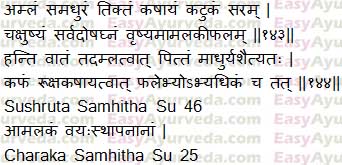
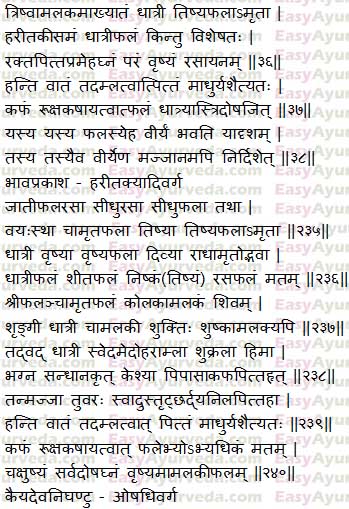
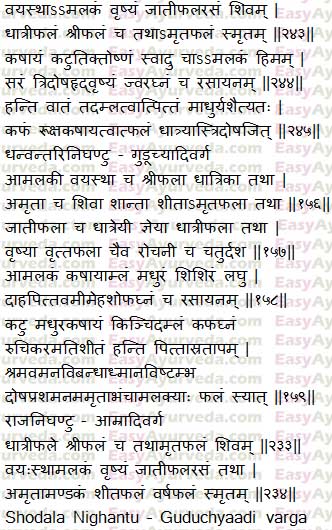
Sthanika Karma (Systemic Action)
External application
Relieve the burning sensation. Good for eyes. promote hair growth. External application of its paste is indicated in Headache due to pitta origin. Juice can be applied on eye disorders. Indicated in premature graying of hair and can be used for hair loss treatment.
Internal administration-
Nervous system – strengthens the central nervous system, promotes intellect, promotes the health of sense organs, and improves vision.
Digestive System – Carminative, digestive, facilitate proper movement of doshas. In lower dose it is absorbent and in higher dose has purgative action. It Indicated in Anorexia, Loss of appetite, constipation, Liver disorders, Acidity, Acid reflux, Ascites, Hemorrhoids etc.
Respiratory system – Pacifies kapha dosha. Indicated in , breathing disorders, cough etc.
Circulatory system – Cardiac tonic, indicated in bleeding disorders
Reproductive system – Aphrodisiac, Helps to retain pregnancy. Indicated in uterine weakness, leukorrhea, Sukrameha, inflammatory diseases of female reproductive tract etc.
Excretory system – increases urine output. Indicated in Dysuria, Renal calculi, UTI, Diabetes etc.
Satmikarana – Indicated in animal poisoning, facture, wounds etc.
Tvak – Indicated in skin disorders
Satmikarana – Rejuvenative
Tapakrama – Indicated in fever (Thirst, burning sensation, jirnajvara)











8 comments on “Amla Benefits, Dose, How To Use, Side Effects, Home Remedies”
Harvesp Sopariwala
Thank you for all the info… A great service to mankind..God Bless you with the Best of everything,
Dahyabhai M. Patel
I am Secretary of Amla Growers Associatino of Gujarat and a progressive farmers, post graduate in Agriculture and very much interested in Medicinal plants, most particularly of Amla, for health to all. I use your website since last 10 years and found it very useful for me and public. Indeed a very informative and useful. I shall be glad to send me pdf file of Amla properties and use or my personal use.from Dahyabhai M, Patel. eM: patel.dahyabhai@redifmail.com. Thanks sir and awaiting your positive response.
Lakshmi
What are the vegetables and fruits that should not be used with Amla? I was looking to replace tamarind with amla in sambar, rasam and similar, hence concerned if amla reacts negatively with vegetables like onions, bindi, carrot, tomato, cucumber and greens like palak or any other vegetables or fruits.
Thanks
Dr J V Hebbar MD(Ayu)
Amla gets along very well with most of the fruits and vegetables. Milk is to be avoided along with amla.
Deepak R
Please teach us the procedure to home-made aamlaa dry murabba for long-duration storage, using NOT sugar but using either jaggery or salt-pepper
Dr J V Hebbar MD(Ayu)
Please see here
https://www.easyayurveda.com/2016/02/17/amla-murabba-recipe-preparation-benefits/
There, sugar can be replaced with jaggery
Samruddhi
Dear Dr. Hebbar,
Is it safe to take while planning to conceiving ?
Dr J V Hebbar MD(Ayu)
Yes, very safe.